Introduction
This website was prepared for a presentation at the 2010 UCDA Design Education Summit in Lawrence, Kansas by Al Wasco, Assistant Professor, Cuyahoga Community College, Cleveland, Ohio. Al's personal website is TheViewFrom32.com.

Instant gratification (executive summary)
Students and teachers live in and navigate the world in very different ways. Age makes a huge difference, with the biggest gaps between young (18-24) students and old (45 and up) faculty.
Big disconnects
(Old) teachers read books and want their students to read books. (Young) students don't read much.
Students play video games. A lot. Teachers ignore video games. Completely.
Possible meeting ground
Both groups like social media, particularly Facebook.
[ Jump to Media Diet survey results ]
Background
The original question (to design educators):
Do you teach software in your design classes, and if so, how much time do you spend teaching theory/concept vs. software/technology?
The question became the basis for my sabbatical research proposal (Dec. 2007):
Trains, Teaching and Technology

Comment by Meredith Davis at AIGA Massaging Media conference (April 2008):
The study of digital media is tacked onto a print-based armature; students get to networked communication courses only after they have met their traditional requirements inn print and only if the human and material resources of the program go far enough to support additional coursework. As a result, these digital media classes frequently encourage the transfer of print-based values to the screen.
The connection?
Teachers are stuck in the past, while students live in the present.
First steps
Online surveys for teachers and students: original surveys (August 2008)
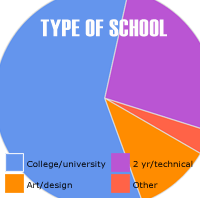 As of June 1, 2010, 154 teachers replied:
As of June 1, 2010, 154 teachers replied:
- 81% sometimes or always teach software in class
- 75% satisfied/very satisfied with how this works
- 82% think students are satisfied/very satisfied.

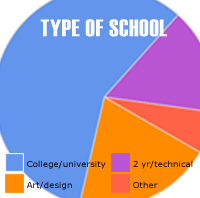 299 students replied:
299 students replied:
- 85% sometimes or always are taught software in class
- 64% are satisfied/very satisfied with this approach
- 86% think instructor is satisfied/very satisfied
Answers to original question
Time teaching design theory/software:
Art/Design Schools: 53%/40%
Community College/Technical Schools: 56%/44%
College/University: 68%/32%
Overall roughly 60% theory, 40% software
Next step: talk to teachers and students
I decided to spend roughly a month traveling by train across the U.S., talking to as many teachers and students as I could. Afterwards I also visited Herron School of Art in Indianapolis and Sinclair Community College in Dayton, Ohio. In all I went to ten schools and spoke with sixteen faculty and a handful of students.
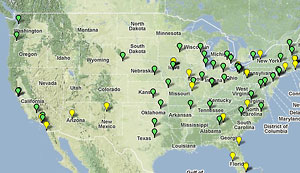 THE ROUTE
THE ROUTE
Survey respondents who said "yes" or "maybe" to a visit, plotted on map. I matched these locations as best I could with the Amtrak route map.
My ultimate route was Cleveland-Santa Fe-Los Angeles-San Francisco-Portland-Milwaukee. Later I drove to Indianapolis and Dayton.
THE PEOPLE
I spoke with a range of instructors and department heads, young and old. You can see and hear many of them in this short video.
Uh-oh
Back home in Cleveland I tried to make sense of what I'd learned. Somewhere between the conversations and the data a big difference became visible.
Mouseover the chart if you haven't already spotted it.
Yep, teachers don't require students to learn software using any specific method except... books. Now, what do we know about students and books?
33% read less than 1 hour per week. 73% less than 5 hours per week.
Teachers, on the other hand, read a lot: 90% more than 1 hour per week, 54% more than 5 hours per week.
These numbers move a bit higher for younger students (age 18-24).
New survey(s)
As I thought about what I'd learned by talking with teachers and students, the differences in how we use media began to loom large as an area of disconnect. I created a simple online survey to ask What's Your Media Diet?
The survey includes questions about age and occupation as well as a matrix of media use questions. If you haven't already, please take the survey.
In a nutshell, here are the results (updated June 9, 2010):
Books
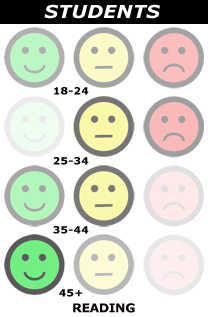
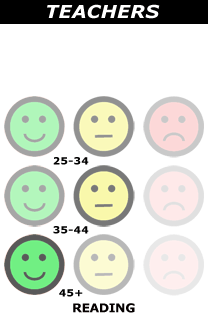 Teachers, especially older ones, see reading as a primary way to acquire knowledge. Students, especially younger ones, don't read much.
Teachers, especially older ones, see reading as a primary way to acquire knowledge. Students, especially younger ones, don't read much.
These charts show that while in general teachers prefer reading more than students, age is the most important factor, not occupation.
Regardless, most college students are in the 18-24 age group, and most teachers are significantly older. In my surveys the largest number of teachers fall into the 45+ group.
Let's take a look at what happens when we compare young students with old teachers:
[mouseover to see comparison]
Pretty dramatic difference, no?
We need to be aware of this as we plan our classes. Our preferences should not determine our choices.
Despite the fact that we like reading books, does it make sense to assign books as the primary information source when we know that students don't read much?
This is not to say that we should ignore books. It does suggest that we might see better results if we assign other types of resources in addition to books. The most-frequently recommended non-book resource is the Lynda.com website.

Games
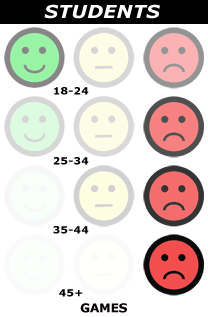
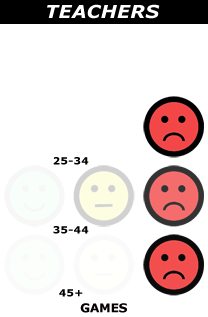 Students spend a lot of time playing video games. Teachers by and large disdain them.
Students spend a lot of time playing video games. Teachers by and large disdain them.
These charts show a huge disconnect. The problem isn't that all students love games, they don't. The problem is that many do, yet virtually all teachers ignore games.
See below for suggestions on how to make games an asset to learning.
Again the age difference is very significant. The contrast is starkly visible when we compare young students to old teachers:
[mouseover below to see comparison]
We can think of this as a problem or an opportunity, but we do need to think about it. Like them or not, we should be trying to figure out how to incorporate game mechanics into our teaching methods. Why not?

Social media
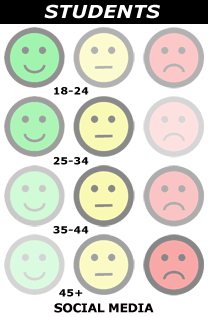
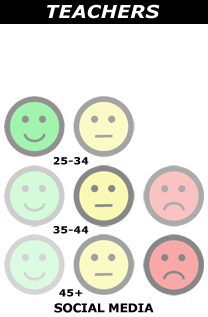 This may be our meeting ground: student and teacher views about social media like Facebook and Twitter are quite similar (Facebook is most frequently mentioned).
This may be our meeting ground: student and teacher views about social media like Facebook and Twitter are quite similar (Facebook is most frequently mentioned).
Again, the difference in age seems more important than whether the response is from a student or teacher. If anything, teachers may be more involved with social media than their students of similar ages.
How can we use this common interest in social media to improve our teaching?
Traits of younger students
Gen X (born 1961-81) = 29-49
Millennials (born 1981-2000) = < 29
To get a sense of the Millennial generation, take the How Millennial Are You? quiz developed by the Pew Research Center.
 You can get a very good overview of many of the issues we're talking about by watching videos created by Anthropology professor Michael Wesch from Kansas State:
You can get a very good overview of many of the issues we're talking about by watching videos created by Anthropology professor Michael Wesch from Kansas State:
Another concept that helps explain the differences in how people use media is Digital natives, Digital Immigrants, by Marc Prensky.

Suggestions
OK, if you're convinced that there are differences and you want to reach out to younger students, what should you do? This is the question I'm most frequently asked. I don't have any good answers yet, but here are a few things you can start with:
If it can be online, put it online (student work, too: real work for real audiences).
If it can be collaborative, make it collaborative (discussions, blogs, wikis, etc.)
If it can be more fun, make it more fun.
If you can make it a game, make it a game.
 Overview
Overview
A short list of helpful websites:
Digital Media & Learning (Howard Reingold's blog)
Millennial Student Resource List (University of Ontario)
Teaching Millennial Students (DePaul University)
Twitch Speed: Keeping up with young workers, Marc Prensky
Specifics
The videos below will start you thinking about how we might relate games and education.
Games are essential to human survival, Jane McGonigal
Using game mechanics to improve software Putting the Fun in Functional, Amy Jo Kim
FreeRice.com is a simple example of this in practice.
